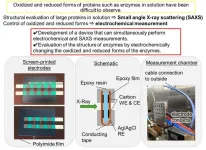Redox enzymes are proteins that catalyze oxidation-reduction reactions, which involve the transfer of electrons between molecules. Redox enzymes are crucial in bioelectrochemical devices, such as biosensors or biofuel cells. For instance, biosensors catalyze reactions that convert biochemical signals into measurable electrical signals, enabling the detection of substances like glucose. In biofuel cells, redox enzymes convert biological energy into electricity, powering small devices like medical implants. Their ability to facilitate the efficient transfer of electrons between molecules makes them indispensable as a sustainable technology for energy conversion and advanced biological monitoring.
However, to harness their full potential, redox enzymes have to be immobilized on solid surfaces to ensure they are stable, reusable, and can interact efficiently with electrodes or substrates. Covalent binding of redox enzymes to electrode surfaces is the most stable and rigid method among the various enzyme immobilization techniques. This technique, however, can render the enzyme inactive owing to the loss of necessary structural flexibility for enzyme activity by an overly rigid immobilization. To select the right immobilization technique, it is necessary to understand the various conformations of redox enzymes. Although many techniques exist for studying enzyme structures, examining the structural differences between an enzyme’s reduced and oxidized forms is challenging.
Several studies have demonstrated the efficacy of using small-angle X-ray scattering (SAXS) combined with electrochemistry in the fields of battery and fuel cell research. However, this approach has not yet been investigated in the context of biological samples. To address this gap, a research team led by Associate Professor Isao Shitanda from the Tokyo University of Science (TUS) in Japan, developed a novel method comprising the use of electrochemical-SAXS (EC-SAXS) to analyze the structural differences between the reduced and oxidized states of enzymes. Their findings, published online in the journal Langmuir on December 31, 2024, were co-authored by Dr. Noya Loew, Ms. Chiaki Sawahara and Associate Professor Taku Ogura from TUS, and Dr. Yuichi Takasaki from Anton Paar Japan K. K., who investigated the structural differences between the oxidized and reduced forms of bilirubin oxidase (BOD) and found that BOD forms an open or closed state depending on its redox state.
Dr. Shitanda explains the team’s approach, “In this study, we drew insights from mediated spectroelectrochemical titration, in situ SAXS, and SAXS analysis of proteins to develop a novel method for the structural analysis of enzymes in their reduced and oxidized states, which we named EC-SAXS.” X-ray scattering profiles of electrochemically oxidized and reduced BOD were obtained at pH 8.0, where its redox potential decreased with increasing pH. There were clear differences in the scattering profiles, which followed a similar trend when compared with individual SAXS profiles of chemically oxidized and reduced BOD. From these experiments, the researchers confirmed that reduced BOD maintains a more compact structure than its oxidized form.
High-resolution imaging data further revealed that BOD has an open conformation when oxidized and a closed form when reduced. In EC-SAXS, where 10 times more concentrated phosphate buffer was used, the negatively charged molecules were likely to have penetrated and expanded the structure of BOD, giving it a more open shape when oxidized. “Notably, the natural substrate for oxidized BOD, bilirubin, which contains two carboxyl groups and is negatively charged, requires access to the active site for reactivity, a process facilitated by the open structure,” comments Dr. Shitanda.
The novel EC-SAXS technique thus reveals that a small redox-enzyme like BOD can be very flexible during its redox cycle, fluctuating between open and closed structures. Furthermore, this study establishes EC-SAXS as a promising technique for studying potential-dependent structural conformations of redox enzymes, advancing our understanding of the reaction mechanisms of redox enzymes. “Insights into structural changes during the redox reaction could enhance the development of tailor-made immobilization strategies, thereby improving the performance of biosensors, biofuel cells, and other bioelectronics,” concludes Dr. Shitanda.
Overall, this method paves the way for developing advanced immobilization strategies, significantly enhancing the performance of enzyme-based biodevices. These advancements have the potential to revolutionize fields like bioelectronics, biosensors, and biofuel cells, leading to more efficient, sustainable, and scalable technologies.
***
Reference
DOI: https://doi.org/10.1021/acs.langmuir.4c03661
About The Tokyo University of Science
Tokyo University of Science (TUS) is a well-known and respected university, and the largest science-specialized private research university in Japan, with four campuses in central Tokyo and its suburbs and in Hokkaido. Established in 1881, the university has continually contributed to Japan's development in science through inculcating the love for science in researchers, technicians, and educators.
With a mission of “Creating science and technology for the harmonious development of nature, human beings, and society," TUS has undertaken a wide range of research from basic to applied science. TUS has embraced a multidisciplinary approach to research and undertaken intensive study in some of today's most vital fields. TUS is a meritocracy where the best in science is recognized and nurtured. It is the only private university in Japan that has produced a Nobel Prize winner and the only private university in Asia to produce Nobel Prize winners within the natural sciences field.
Website: https://www.tus.ac.jp/en/mediarelations/
About Associate Professor Isao Shitanda from Tokyo University of Science
Dr. Isao Shitanda graduated from the Tokyo University of Science (TUS) in 2001 and received a PhD from The University of Tokyo, Japan in 2006. Since 2012, he has served as an Associate Professor at the Department of Pure and Applied Chemistry at TUS, leading the Itagaki/Shitanda lab. He specializes in electrochemical micro/nano systems, physical and analytical chemistry, bio-related chemistry, and environmental chemistry, among other fields. He has published over 180 papers and holds six patents.
END





